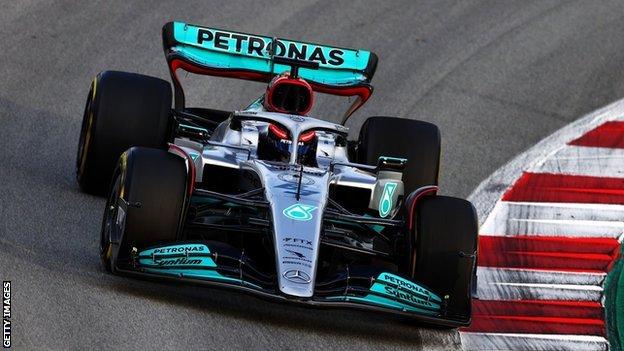
Mercedes are behind Ferrari and McLaren after two days of pre-season testing, says driver George Russell.
The 24-year-old, who has joined fellow Briton Lewis Hamilton at Mercedes, said they were “certainly not ahead”.
“Some teams are looking pretty fast – a red team and an orange team in particular look very competitive,” said Russell, alluding to the colours of the Ferrari and McLaren teams.
“They seem to have things well under control and are on top of everything.”
Russell was fourth fastest on Thursday – the second day of pre-season testing – behind Ferrari’s Charles Leclerc, Alpha Tauri’s Pierre Gasly and McLaren’s Daniel Ricciardo.
Leclerc’s fastest time was just over 0.1 seconds slower than the fastest time of the test so far, set by McLaren’s Lando Norris on Wednesday.
Headline lap times in pre-season testing are notoriously poor indicators of actual competitiveness because so many factors can cloud the true picture – including tyre selection, fuel load, engine modes and track conditions.
Russell said McLaren and Ferrari “look very strong on low fuel and high fuel and with the tyre management”.
He added: “Who knows? We all know we’re on different programmes but we definitely know from the average of all the different runs that we are behind them at the moment.
“A world championship is not won in two days in Barcelona winter testing but it’s certainly been an intriguing two days.”
Leclerc cautioned against reading too much into Ferrari’s pace early in pre-season, adding: “I enjoyed it. It’s interesting to finally be able to push a bit more the car and understand how different a driving style we need to have.
“A positive day, we have done many laps and slowly we get to understand the car and push it a bit more.
“In the high-speed [corners] it is feeling quite good. In the low speed, you feel a bit more the weight of the car, especially in braking and the last sector but overall the feeling is not too bad.”
F1 has introduced new regulations this year in an attempt to generate closer, more competitive racing. This has led to a significant variation in car design among the 10 teams.
Ferrari team boss Mattia Binotto said: “The times are very close, which was one of the intentions of the new regulations. And the cars are so different.
“There will be differences in lap time, but not as big as the differences in designs.”
Of the other drivers from last year’s top teams, Red Bull’s Sergio Perez – who took over the car from world champion Max Verstappen for the day – was seventh fastest.
Seven-time champion Hamilton was 16th and slowest after stepping into the Mercedes for the afternoon session, using only the hard ‘C2’ compound of tyre.
Alfa Romeo finally managed to get a significant number of laps under their belts after a difficult first day. New driver Guanyu Zhou was ninth fastest, managing 71 laps in the afternoon, after Valtteri Bottas did 21 in the morning session.
Why are the cars bouncing?
Russell said Mercedes were one of the many teams suffering from a phenomenon whereby the cars bounce on the straights.
This is caused by the powerful underbody aerodynamics losing their effect as the car moves closer to the ground, jumping up as a result of the reduced aerodynamic load, and then sinking again as it returns. This turns into a cycle as the car moves down the straight and is something the teams will need to optimise before the season starts next month.
Russell said: “You could see some substantial issues with some of the cars in the straights and the bottoming.
“It’s a compromise we need to find to go quickest around the lap and I don’t think it’s anything the teams have experienced before.
“We didn’t experience it too much for one reason or another but it’s not very pleasant at all.
“From what I’ve seen from the teams it would be a safety concern so it does need to be sorted one way or another, but there’s a lot of intelligent people up and down the grid and I am sure everyone will get on top of it.”
Binotto said: “Most of us underestimated the problem and we are bouncing more than expected.
“How long it takes to address or solve? Solving it can be straightforward but optimising the performance could be a less easy exercise.
“I am pretty sure each team will get to a solution and the ones that get there sooner will have an advantage.”
What were the drivers’ fastest times?
1 Charles Leclerc (Mon) Ferrari one minute 19.689 seconds
2 Pierre Gasly (Fra) Alpha Tauri 1:19.918*
3 Daniel Ricciardo (Aus) McLaren 1:20.288*
4 George Russell (GB) Mercedes 1:20.537
5 Carlos Sainz (Spa) Ferrari 1:20.546s
6 Sebastian Vettel (Ger) Aston Martin 1:20.784
7 Sergio Perez (Mex) Red Bull 1:21.430
8 Nikita Mazepin (Rus) Haas 1:21.512s
9 Alex Albon (Tha) Williams 1:21.531s
10 Guanyu Zhou (Chi) Alfa Romeo 1:21.885s
11 Nicholas Latifi (Can) Williams 1:21.894s
12 Lance Stroll (Can) Aston Martin 1:21.920s
13 Mick Schumacher (Ger) Haas 1:21.949
14 Esteban Ocon (Fra) Alpine 1:22.164
15 Valtteri Bottas (Fin) Alfa Romeo 1:22.288s
16 Lewis Hamilton (GB) Mercedes 1:22.562s**
* denotes C4 compound tyre; ** denotes C2 compound; all other times set on C3 tyre. C1 is hardest, C5 is softest.


